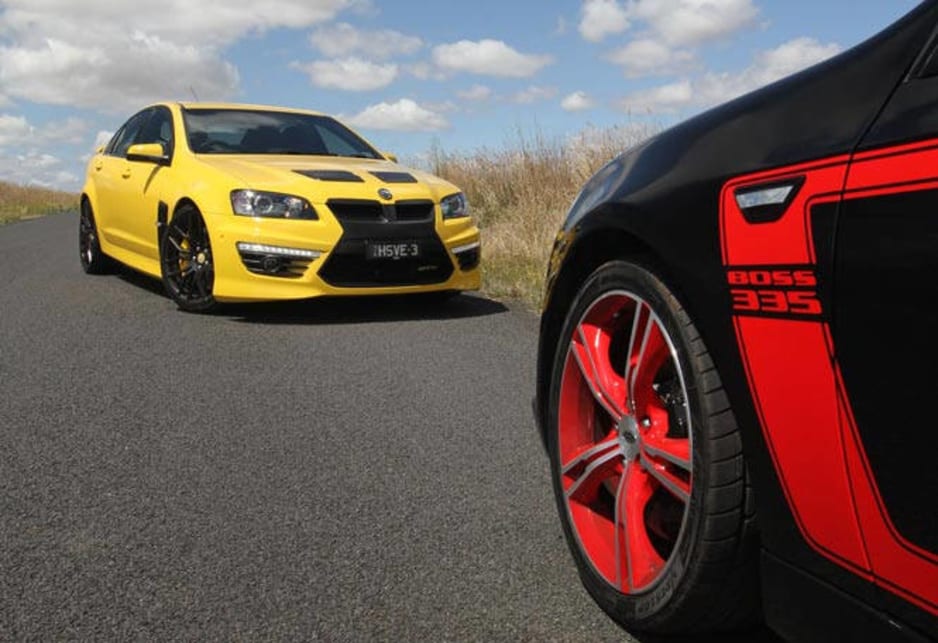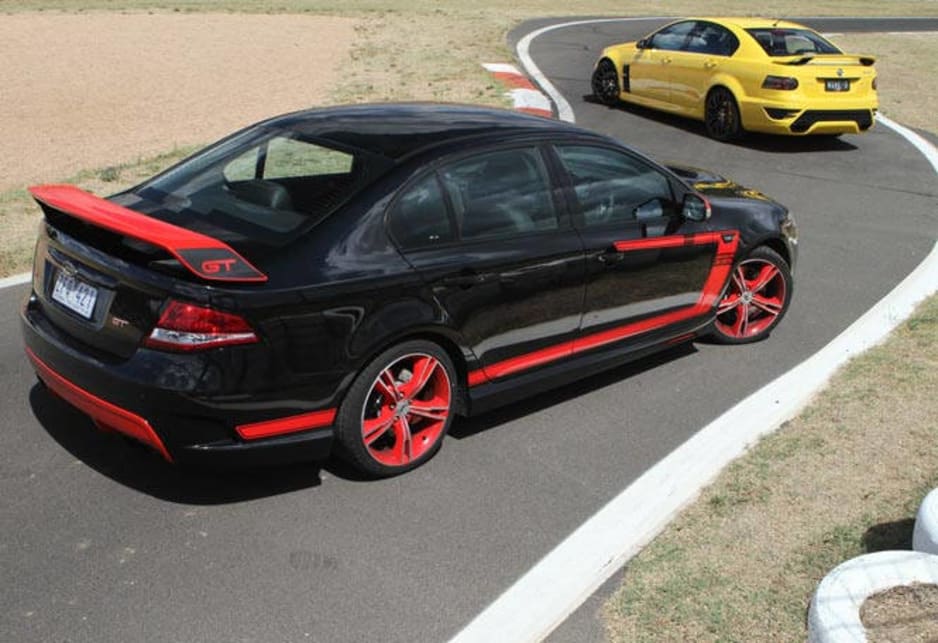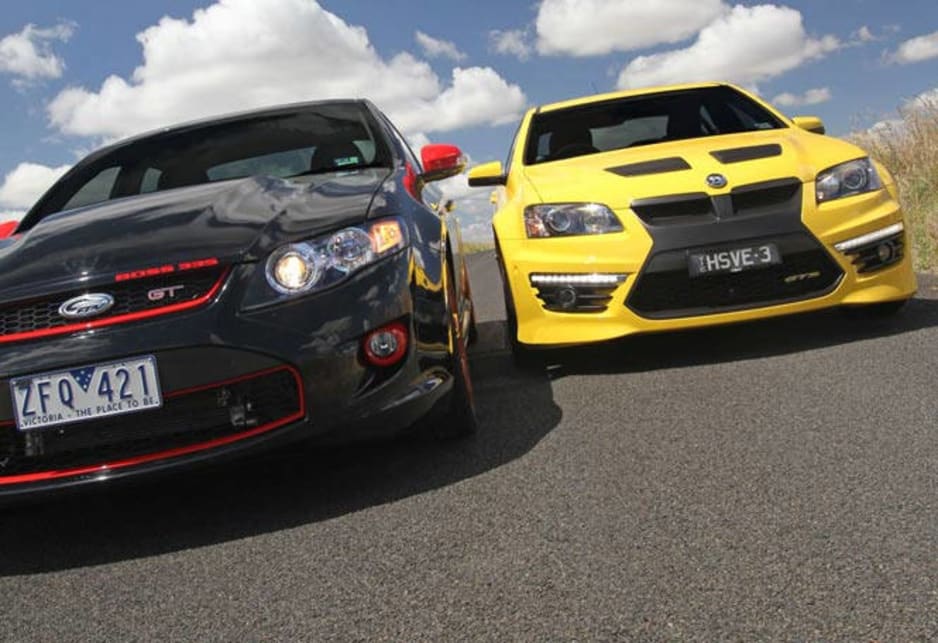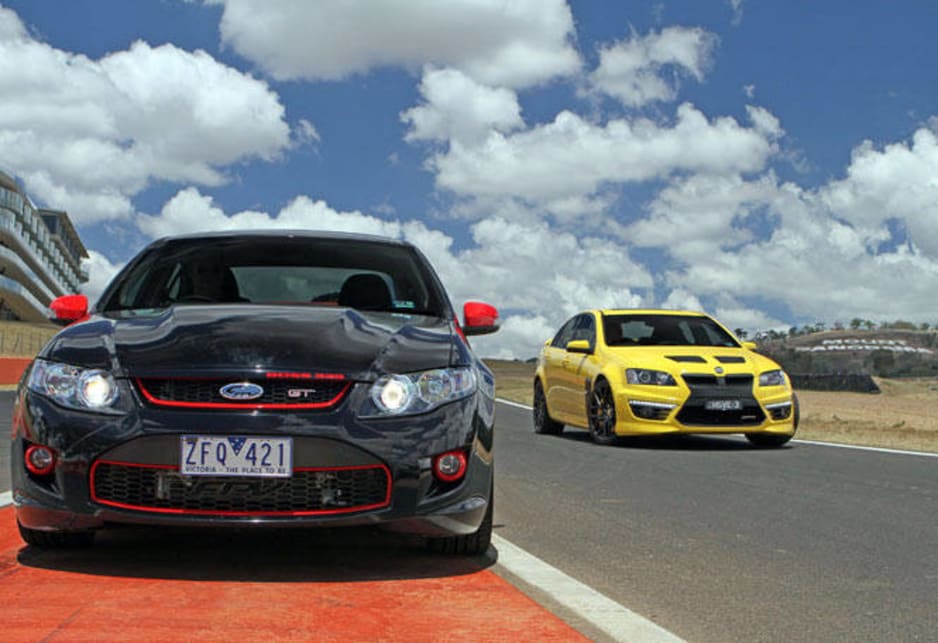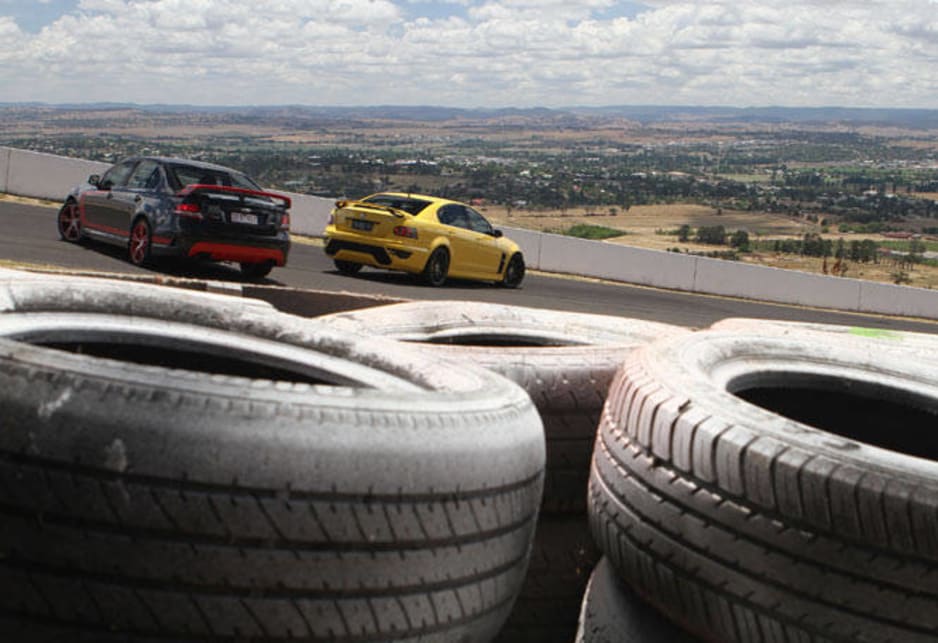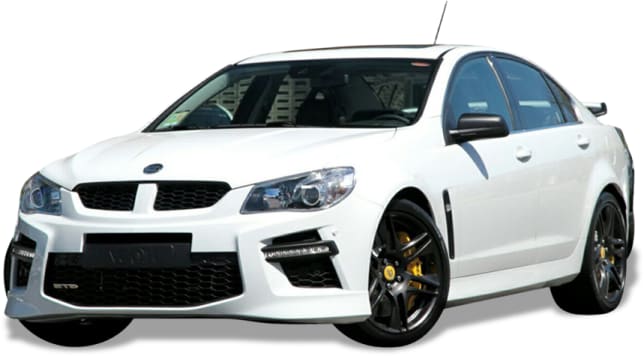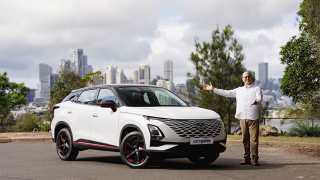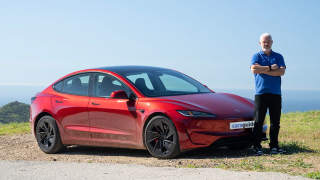
HSV GTS vs FPV GT 2013 Review
- HSV GTS
- FPV GT
- HSV GTS 2013
- FPV GT 2013
- HSV GTS Reviews
- FPV GT Reviews
- HSV Reviews
- FPV Reviews
- HSV Sedan Range
- FPV Sedan Range
- Sedan
- HSV
- FPV
- Sports cars
They are the latest – and the greatest – of their current breed: the HSV GTS 25th anniversary edition and the supercharged FPV Falcon GT in its fittest form yet, the limited edition R-Spec.
They represent the best from both brands before Holden’s updated Commodore arrives in showrooms in the middle of next year and Ford’s refreshed Falcon in 2014.
Although the new-car sales race is more about the battle between Toyota, Mazda, Hyundai and others these days, many Australians still hold their childhood Holden-v-Ford rivalries close to their hearts – even if they’re driving an imported hatch or SUV that better suits their lifestyle.
To help keep the dream alive we brought these two V8 kings of the road together for a final fling to the mecca of Australian motorsport: Bathurst.
FPV GT R-Spec
VALUE
The FPV GT R-Spec starts at $76,990, about $5000 more than the regular GT. For that, you get no extra power – but you do get reworked suspension and, crucially, wider rear tyres that provide much needed grip
Which is why the R-Spec is quicker than the standard GT to 100km/h – the fatter rubber at the rear means it launches better. Ford doesn’t make an official 0 to 100km/h claim but the GT now dips comfortably below the 5-second mark (internal testing showed a time of 4.5 seconds in ideal conditions), making it the fastest Australian-made car of all time.
The black bodywork with orange highlights – and a “C”-shaped stripe along the flanks – are designed to pay homage to the iconic 1969 Boss Mustang. This is the most popular colour combination, with 175 made. The remaining 175 R-Spec models were red, white or blue with black stripes.
Compared to a regular GT, the R-Spec price is steep – and FPV still charges $5995 for six-piston front brakes on the fastest Falcon ever made. It’s a moot point, however. Ford fans have snapped up all 350.
TECHNOLOGY
The GT R-Spec saw the debut of launch control for FPV – on both manual and automatic versions (HSV only has launch control on manual cars). We drove the GT R-Spec manual a few months ago, but on this occasion had the automatic on hand.
This may come as a shock to diehards but the automatic is the pick. The six-speed manual loses too much acceleration between gear-changes, and thumps and groans in the process. Muscle car fans may like the manual’s brutish feel but, by comparison, the six-speed automatic GT feels like you’re strapped to a rocket.
ACCOMODATION
The Falcon is roomy and comfortable, it’s just a pity there isn’t more visual differentiation between the GT and the standard models inside (a logo on the instrument cluster and a red starter button).
Despite the price the GT misses out on other touches such as auto-up power windows and fully electric adjustment on the front seats (both standard on the HSV GTS).
The seats are the same as those used in XR Falcons, but with unique stitching. There’s modest under thigh and lateral support but the lumbar adjustment is good.
SAFETY
Stability control, six airbags and five-star safety mean the fastest Falcon is also the safest ever made. The wider rear rubber improves road holding.
But six-piston front brakes should be standard, instead it gets the regular four-piston brakes. Apart from a rear camera, there are no other safety gadgets.
DRIVING
This is the Falcon GT that should have bowed in 2010 when the supercharged V8 was installed – but the extra chassis development and wider rear wheels were delayed by the Global Financial Crisis of 2008.
Thankfully, FPV engineers forged ahead to give their mighty supercharged V8 the traction it sorely needed. The suspension is a lot firmer than before – and slightly more so than the HSV – but the net result is a car that has a significantly higher threshold of grip.
(The wheels are still 19-inch in diameter as the Falcon can’t house 20-inch rims and still meet Ford’s clearance requirements. HSV has had 20-inch, “staggered” wheels since 2006).
The shifts in the six-speed auto are smooth, enabling you to extract the most from the engine, although sometimes it doesn’t kick-down to a low-enough gear.
The characteristic supercharger whine sounds superb, as does the V8 Supercar-like exhaust system, which does a good job of drowning out the intrusive tyre noise on coarse-chip surfaces.
Overall, though, this is the first Falcon GT I’m genuinely excited about – and the first time I’d consider Ford’s supercharged V8 over its awesome turbocharged six-cylinder sibling.
HSV GTS 25
VALUE
At $84,990, the 25th anniversary edition of the GTS is $2000 more than the standard GTS and, as with the Ford, gets no extra power. But HSV has added $7500 worth of equipment including six-piston front brakes, blind-zone warning and new, lightweight wheels.
The “Darth Vader”-style bonnet scoops and fender vents are borrowed from the anniversary edition HSV Maloo of two years ago. It also gets black highlights and exhaust tips, and 25th anniversary stitching in the seats and badging on the boot and door sills.
Only 125 have been made (in yellow, black, red and white). All are sold, and no more GTS models will be built until the updated Commodore arrives in June.
TECHNOLOGY
In addition to the aforementioned blind-zone warning (the first on an Australian-made car, it detects nearby vehicles in the adjacent lanes) the GTS has a raft of gadgets that not even Nissan’s hi-tech GT-R and Porsche’s 911 have.
The GTS has an onboard computer than enables you to track the vehicle’s engine and suspension performance, G-force, fuel economy and track-trace lap times on every race circuit in Australia – with room to add more.
Unlike the two-mode exhaust on the Ford, the HSV’s exhaust system can be switched to loud or quiet via the same interface. Launch control is only available on the manual GTS, but its stability control has two settings: standard, and a track mode that loosens the leash a little.
The magnetically-controlled suspension (also used on Corvettes, Audis and Ferraris) has two settings: performance and track mode. A little known feature: the HSV’s cruise control will automatically apply the brakes to control speed downhill (other systems control only the throttle, not the brakes, and the speed can creep).
LED daytime running lights and the LED tail-lights were firsts on Australian-made cars when introduced.
ACCOMODATION
The Commodore is roomy, with ample adjustment in the steering and seating to find the perfect driving position. The bulging steering wheel, unique instrument cluster and gauges provide important differentiation from the standard car.
The lower seat cushions have good under thigh and lateral support but not as much lumbar adjustment as the Ford. The optional sunroof fitted to the test car robbed our 187cm-tall (6ft, 2in) test-drive companion of headroom. As much as he enjoyed the GTS, it became too uncomfortable and did the majority of his time in the Ford.
SAFETY
Stability control, six airbags, five-star safety and ample grip – and the biggest brakes fitted to a locally-made car – have all the bases covered.
Side blind-zone alert is a handy feature (especially given that the Commodore’s mirrors are so small) and the rear camera helps squeeze into tight parking spots. But the thick windscreen pillars still block your view in some bends – and pedestrian crossings.
DRIVING
The HSV GTS is not as quick as the FPV GT R-Spec – especially when the Holden is a manual – but it’s still fun to drive, and capable of a low 5-second dash to the speed limit.
The lightest 20-inch rims ever made by HSV trim 22kg from the overall weight and subtly improve steering feel. My favourite part, though, is the crackle and burble of the bi-modal exhaust on over-run and between gearchanges.
The brake pedal feel is superb, too. I prefer the HSV’s slightly better damped suspension, and the car is quieter at cruising speeds.
VERDICT
In many ways the outcome of this exercise is academic because buyers from both camps rarely switch sides. The good news is that true believers in Ford and Holden have world-class cars to choose from – which wouldn’t exist without the fleet versions of the Falcon and Commodore on which they’re based.
Nevertheless, this result may make for difficult reading for Holden fans. HSV has had the upper hand in performance and handling over its Ford rival for some time, but the latest FPV GT R-Spec finally turns the tables.
HSV still leads with technology, equipment, all-round refinement and overall capability – but if power and control are the primary criteria, the FPV GT R-Spec wins this contest. Being several thousand dollars cheaper than the HSV simply seals the deal.
FPV GT R-Spec
Price: from $78,990
Warranty: Three years/100,000km
Service interval: 15,000km/12 months
Safety rating: 5 stars
Engine: Supercharged 5.0-litre V8, 335kW, 570Nm
Transmission: Six-speed automatic
Thirst: 13.7L/100km, 324g/km
Dimensions (L/W/H): 4970/1864/1444mm
Weight: 1857kg
Spare wheel: Full size alloy (front)
HSV GTS 25th anniversary
Price: from $84,990
Warranty: Three years/100,000km
Service interval: 15,000km/9 months
Safety rating: 5 stars
Engine: 6.2-litre V8, 325kW, 550Nm
Transmission: Six-speed manual
Thirst: 13.5L/100km, 320g/km
Dimensions (L/W/H): 4998/1899/1466mm
Weight: 1845kg
Spare wheel: Inflator kit. Spare wheel $199
Pricing guides
Range and Specs
| Vehicle | Specs | Price* | |
|---|---|---|---|
| 25th Anniversary | 6.2L, —, 6 SP MAN | $40,700 – 47,850 | 2013 HSV GTS 2013 25th Anniversary Pricing and Specs |
| 25th Anniversary (Dual Fuel) | 6.2L, —, 6 SP SEQ | $44,990 – 52,360 | 2013 HSV GTS 2013 25th Anniversary (Dual Fuel) Pricing and Specs |
| (base) | 6.2L, —, 6 SP MAN | $58,300 – 66,990 | 2013 HSV GTS 2013 (base) Pricing and Specs |
$84,864
Lowest price, based on 4 car listings in the last 6 months



